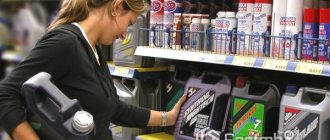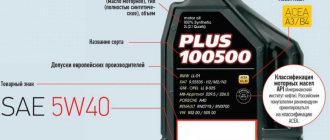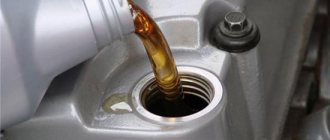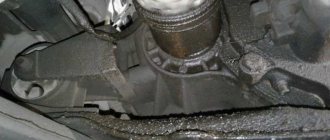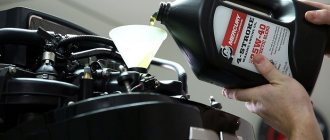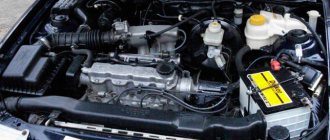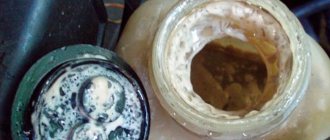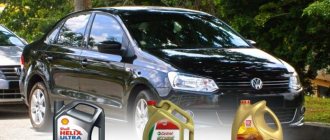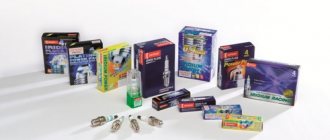Original German autobuffers Power Guard
Mirror-video recorder FUGICAR FC8
Sun blinds Trokot with magnets!!!
One of the commonly used lubricants is 10W40 oil. Its interpretation reflects the characteristics and properties of year-round use in various types of engines. The abundance of motor oils on the market allows you to select a lubricant for an internal combustion engine with any requirements. Many manufacturers offer motor oils with different base stocks, additive packages and characteristics.
Marking
The classification of motor oils is provided by the SAE J300 system, which was developed by the Society of Automotive Engineers. The higher the number in the material labeling, the greater the viscosity. The designation also indicates the season of operation of the lubricant. A number of winter oils have the index W (winter).
The number before the letter indicates the low-temperature indicators of the lubricant: pumpability and crankability. The first characterizes the temperature at which the oil viscosity is low enough for normal passage through the pipeline. Crankability indicates the minimum temperature at which an engine can be started with a particular type of lubricant.
| Index | Low temperature viscosity values | |||||
| 0W | 5W | 10W | 15W | 20W | 25W | |
| Pumpability | -40 °C | -35 °C | -30°C | -25 °C | -20 °C | -15 °C |
| Cranking | -30°C | -25 °C | -20 °C | -15 °C | -10°C | -5 °C |
The summer range of oils is indicated only by a number.
| SAE Viscosity Index | 30 | 40 | 50 | 60 |
| Maximum temperature | +25 °С | +40 °С | +50 °С | +50 °C and above |
The SAE 10W-40 marking is a combination of winter and summer lubricants. This is an all-season oil that prevents dry friction in engine components in winter and ensures reliable lubrication of parts in summer. The technical characteristics of 10W-40 motor oil indicate that it is suitable for use in central Russia.
Additives
To improve the properties of the lubricating fluid, special chemical components are used. They are collectively called additives. Therefore, sometimes it is not enough to know the basic properties of 10W-40. A breakdown of the full characteristics is indicated by the manufacturer on the packaging, including the type of additive, its technical parameters and content.
There are many different types of additives. Some of them are added directly by the manufacturer, some are sold separately for independent use.
The most popular types at the moment are:
- Increasing viscosity index.
- Removing combustion products from the internal surface of the engine.
- Increases wear resistance.
- Preventing the development of oxidative processes.
Before adding each of them, you should carefully read the instructions for use. Indeed, in addition to the positive effect, side effects may also occur.
Viscosity 10W-40
| VISCOSITY SAE | 10W-40 |
| Density (at 15oC) | 0.866 |
| Kinematic viscosity, mm2/s at 40 °C | 106.9 |
| Kinematic viscosity, mm2/s at 100 °C | 15.1 |
| Viscosity index | 147 |
| Pour point (oC) | -42 |
| Flash point (оС) | 234 |
| PKG | 1,3,4,200 |
But what about the transition from one oil to another?
Knowledgeable drivers will immediately object that the oil in the engine cannot be completely “clean”, and in any case the liquids are mixed during the seasonal oil change. And they will be right. This is especially true for those who are going to fill a car with a different type of composition - synthetics instead of mineral water, for example. Or when moving to another region where a composition with different properties is required.
| For cold temperatures, it is possible to slightly reduce the value after W, i.e. take 30 in place of 40. This way you will slightly reduce fuel consumption while the engine warms up. The same should be done for urban conditions. |
Indeed, no matter how thoroughly the engine is drained and cleaned with flushing oils, 3-5% of the lubricating fluid will still remain on the cylinder walls and in the most inaccessible corners. This means that mixing of oils, even in small volumes, will definitely happen, and it’s hardly possible to do anything about it, and it’s not really necessary. The main thing is to follow the oil change schedule and do not let the car run on an old composition with a spent resource. Then mixing the waste residues with the new lubricating fluid will definitely be harmless, even if you did not use flushing.
| In any case, it is better to use oils from one manufacturer: this way you will reduce the risk of a reaction with unpredictable consequences. For example, if you drove with Shell brand oil with a viscosity of 10W-40, then fill in 5W-40 oil from the same Shell and safely start the engine. |
What else to pay attention to
In the marking of 10W-40 oil, in addition to the SAE viscosity-temperature characteristics, the API service class is also indicated. This classification was developed by the American Petroleum Institute. According to the API system, all oils can be divided into two categories:
- S (Service) - intended for gasoline engines of cars, trucks, and minibuses;
- C (Commercial) - intended for diesel engines of trucks, industrial, road construction, and agricultural equipment.
The second letter in the API marking indicates the level of performance characteristics. The further it is from the beginning of the alphabet, the higher the quality. For category S, higher classes can replace lower ones. The designation is usually indicated through a fraction, for example SF/CC or CD/SF. If the first letter is S, the oil is preferable to use in gasoline engines, if C, in diesel engines.
Purpose of semi-synthetics and conditions for its use
One of the main advantages of semi-synthetics over mineral oils is the reduction in the volume of low- and high-temperature deposits that are inevitable when using a mineral base that is not stabilized by a powerful additive package. Semi-synthetic 10W-40 is capable of working in demanding modern engines, which is confirmed by API/ACEA quality certification. At the same time, the oil life increases, allowing you to increase service intervals.
Therefore, semi-synthetics can be considered a universal oil that can work in almost all engines without specific requirements. However, it must be taken into account that if the manufacturer uses synthetic oils in the factory fill and during service, then the replacement intervals indicated by him must be reduced when switching to semi-synthetic 10W-40.
Recommendations for using SAE 10W-40 oil
- If synthetic oil with other characteristics is initially recommended for your car, it is recommended to switch to 10W-40 after 100,000-200,000 km. This oil has a less alkaline base and is gentle on older engines.
- If possible, drive the car carefully, without sudden acceleration or braking. Any excessive load on the motor reduces the life of the lubricant and the engine itself.
- Start driving after the car has reached operating temperature. The engines of modern cars are adapted to cold starts, but they are not designed for high speeds from the very start.
- Don't forget to change the oil promptly. Manufacturers indicate service intervals in the technical product data sheet. If the machine is operated in difficult conditions, it is better to reduce the period between replacements.
- Give preference to quality lubricants. Cost is a secondary factor when choosing an oil. Buy materials from manufacturers who guarantee product quality.
Results
Oils of the same viscosity grade, having the same specifications, made and based on the same oil base, generally do not interact aggressively. But if you do not want to have big troubles, it is better to add no more than 10-15% of the total volume. Soon after adding oil, it is better to change the oil completely.
Before choosing an oil, you should find out:
- vehicle release date;
- presence or absence of forcing;
- presence of a turbine;
- engine operating conditions (urban, off-road, sports competitions, cargo transportation);
- minimum ambient air temperature;
- degree of engine wear;
- degree of compatibility of the engine and oil in your car.
To understand when to change the oil, you need to focus on the documentation for the car. For some cars there are extended periods (30,000-50,000 km). For Russia, taking into account the quality of the fuel, operating conditions and harsh climate, it should be replaced after 7,500 - 10,000 km.
It is necessary to periodically monitor the quality and quantity of oil. Pay attention to its appearance. The mileage of the vehicle and the number of engine hours (running time) may not correspond to each other. While in a traffic jam, the engine operates in a thermally loaded mode, but the odometer does not spin (the car does not drive). As a result, the car did not travel very far, but the engine worked a lot. In this case, it is better to change the oil earlier, without waiting for the required mileage on the odometer.
Engine oil 10W-40 from
sells lubricants of its own production. We offer favorable prices for 10W-40 motor oil and at the same time guarantee high quality.
Product advantages:
- compliance with the requirements of ACEA, OEM, API standards, requirements of the world's leading automakers;
- a wide range of oils for engines of any type and age;
- modern technologies and formulations to increase the service life of motors;
- adaptation to Russian climatic conditions;
- high performance characteristics confirmed by certificates.
For questions regarding the supply of SAE 10W-40 motor oil, call us or come to our office in Obninsk for a personal consultation. We will prepare an individual commercial offer tailored to your needs. You can buy oil at retail at your nearest store. Addresses of sales points are listed on the “Where to Buy” page.
Comments
Motor oil is one of the main technical fluids that allows any car to maintain its performance over many years of service. It is the oil that ensures the uninterrupted operation of the power unit by enveloping with a protective film all the mechanisms involved when the engine is turned on and preventing their rapid wear. Motor oils labeled 10w 40 are very popular among motorists. Let's try to figure out which engines it is suitable for, what its name hides and what technical characteristics of 10w 40 oil should be remembered.
Review of SAE 10W-40 motor oils
SINTEC PLATINUM SAE 10W-40 API SN/CF
This motor oil is manufactured using modern synthetic technologies. It is intended for lubrication of gasoline and diesel engines of modern passenger cars. The composition is also suitable for use in SUVs, minibuses and light trucks. Synthetic oil PLATINUM SAE 10W-40 is created taking into account the characteristics of modern engines and provides their maximum protection.
It has approvals from JASO MA2, API (SL/SN/CF), ACEA (A3/B3 A3/B4), etc. Its characteristics allow all-season use. Other advantages of this composition:
- ensuring quick and easy engine starting even at low (above –30 °C) temperatures;
- high lubricity from the first minutes of engine operation;
- improved anti-oxidation characteristics, which extend the life of the oil and increase the time between changes;
- introduction of highly effective detergent additives into the composition, which ensure cleanliness of the engine walls;
- reliable protection against wear even with constant use of the vehicle in difficult urban conditions.
Some car owners consider a small variety of packaging to be a disadvantage. The manufacturer sells Platinum 10W-40 motor oil under the SINTEC brand in 4-liter cans and 216.5-liter barrels.
SINTEC LUX SAE 10W-40 API SL/CF
The semi-synthetic composition is intended for use in modern gasoline and diesel engines with turbocharging and a catalyst. It is suitable for passenger cars and commercial (small buses) vehicles. The oil is based on a synthetic base component. It is complemented by a package of the latest high-tech additives. The latter provide the composition with excellent performance characteristics. Also, when used, the oil does not have a negative effect on the catalytic converter of cars.
The positive features of LUX SAE 10W-40 include:
- high protective indicators. The composition prevents the formation of soot and deposits, helps reduce wear, and minimizes the harmful effects of corrosion. Moreover, the protective properties are preserved even under harsh operating conditions;
- ensuring easy engine starting in cold weather. It is important to take into account that the pour point of the oil is –38 °C;
- good stability of viscosity-temperature parameters.
Semi-synthetic oil LUX SAE 10W-40 does not have approvals from global automakers. When determining the possibility of its use in a car engine, one should be guided by the API and ACEA classifications.
SINTEC SUPER SAE 10W-40 API SG/CD
Semi-synthetics are intended for used gasoline cars (manufactured before 1993). It is also suitable for diesel engines of cars and trucks. This oil can be poured into domestic and foreign cars. To satisfy the needs of a wide range of customers, the manufacturer bottles it in containers of different volumes: from 1 to 216.5 liters. SUPER SAE 10W-40 motor oil is made from highly purified base components with the addition of a package of modern effective additives.
A balanced composition and high-quality raw materials provide:
- increased lubricant service life. The package includes additives that reduce oxidative processes;
- stability of viscosity-temperature properties. This means that the oil will perform its functions equally effectively under different temperature conditions;
- reduced waste costs;
- improved anti-corrosion properties;
- ability to keep the engine clean. Detergent and dispersant additives are responsible for this;
- easy and quick engine start in cold weather.
Semi-synthetic motor oil SINTEC SUPER 10W-40 is characterized by a pour point of –38 °C. This point should be taken into account when purchasing.
SINTEC MOLYBDEN SAE 10W-40 API SJ/CF
Premium motor oil, the formula of which is enriched with molybdenum disulfide. The semi-synthetic composition is intended for lubricating diesel and gasoline engines produced in 1996 and earlier. It can be poured into engines of passenger cars and trucks of Russian and foreign production. Its important advantage is the absence of harmful effects on the catalytic converter. When developing and manufacturing the composition, high-quality bases and additives (including anti-wear ZDDP) are used.
The inclusion of molybdenum made it possible to achieve fuel efficiency and reduce wear of rubbing components. Other advantages of MOLYBDEN SAE 10W-40 oil include:
- the presence of extreme pressure and anti-friction characteristics;
- almost instantaneous lubrication of the motor during a cold start, as well as at low temperatures (down to –30 °C);
- the ability to protect the engine from carbon deposits;
- high anti-corrosion performance;
- preservation of lubricating properties under different operating conditions.
This semi-synthetic oil is sold in containers with a maximum volume of 5 liters. This is not entirely convenient for transport and other companies with a large fleet of vehicles.
SINTEC STANDARD SAE 10W-40 API SG/CD
Mineral oil is intended for cars with gasoline (non-turbocharged) engines produced in 1989-1993 and earlier. Also suitable for vehicles with moderately supercharged diesel engines. Can be used in minibuses and light commercial vehicles with the appropriate API level. This motor oil is an all-season motor oil; it can be used in the temperature range from +40 to –30 °C, that is, it does not require replacement when changing warm and cold seasons. The lubricating fluid is made from high-quality base oils. To improve operational parameters, a package of modern additives is introduced into the composition.
The main advantages of STANDARD SAE 10W-40 oil include:
- relatively low cost;
- versatility - the composition is suitable for cars of domestic and foreign production;
- the ability to protect the engine from rapid wear, corrosion damage and carbon deposits;
- good dispersing and antioxidant characteristics.
At the same time, STANDARD SAE 10W-40 mineral oil from the SINTEC brand does not have an energy-saving effect. It is also important to replace it in a timely manner.
Chemical properties of products
As a base mixture for the production of oils labeled 10w 40, only a high-quality synthetic composition is used with the addition of inexpensive mineral water. The result is a product that allows the motor to function as smoothly as possible, without failures or disturbances.
Thanks to the addition of additives, oils of this group are capable of ensuring reliable engine starting even in very cold seasons or in hot weather. In addition, additives allow the lubricant to actively cleanse the engine of negative formations. Even if toxins have been deposited, in the future they will be washed off with cleaning additives and settle in the filter cartridge.
In addition to the listed points, lubricants of this group reduce wear of parts, prevent soot from appearing and individual parts of the engine from oxidizing. The oil film formed is strong enough to protect the engine of the respective vehicle.
Specifications
Specifications are a set of recommendations for the use of oil for gasoline or diesel engines. They are developed by various associations, institutes and associations. In Europe, the most common are SAE, ACEA, in the USA - API.
The standards of these organizations are used by any self-respecting manufacturer. As part of motor oil standardization, communities examine formulations for specific values and provide recommendations for their use. Each such recommendation has a alphanumeric designation.

